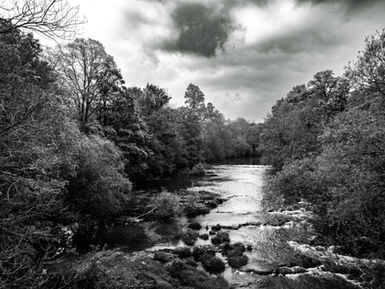Strung along the snaking banks of the River Severn, Newtown was born in the medieval period but truly came of age in the Industrial Revolution. This was when demand for Welsh wool made it a centre of the textile business, giving it the nickname the ‘Leeds of Wales’. Today it’s a lively, modern town and hub for the small villages dotted throughout the green hills and valleys that surround it.
The focal point is aptly named Broad Street, a wide and handsome shopping thoroughfare that sweeps through the centre of town towards the bridge over the river. It’s lined with an eclectic mix of shops, pubs, cafés and restaurants that run from familiar high-street names to one-of-kind Newtown originals.
Broad Street is also a good place to get a feel for the town’s heritage – a long timeline told in its architecture that includes smart, red-brick townhouses, glazed Victorian shopfronts and half-timbered buildings painted in traditional colours of black and white.
Social worker
Get to know Robert Owen, Newtown’s most famous son. Born here in 1771, he rose from modest beginnings as a saddler to become both a wealthy industrialist and philanthropic father of the global cooperative movement. He’s often referred to as ‘Britain’s first socialist’, thanks to a lifetime of efforts to improve the working and living conditions of the Industrial Revolution’s rapidly growing working-class population.
You can find out all about the great man’s life and achievements at the Robert Owen Museum, located in a handsome timber-framed building close to the town clock (just a few feet from the place where he was born). If you’d like to explore his story a little further, look out for the bronze statue of him which stands in the little park on Shortbridge Street and the ruins of St Mary’s Church on the banks of the River Severn, home to the striking tomb, Owen’s final resting place.
Fabric of life
Housed in a former hand-loom weaving factory built in the 19th century, Newtown Textile Museum tells the tale of the town’s past as one of the UK’s cloth-making centres. The top two floors unravel the journey of wool from fleece to flannel, with an impressive collection of antique looms and spinning wheels. You’ll see live displays of woolcraft and weaving, using both 19th-century and modern methods – plus a treasure trove of artefacts that shed light on the lives of the people who once worked here.
In the former cottages that make up the building’s first two floors, a collection of exhibits tells the story Newtown’s transformation from a rural Mid Wales town to a centre of industry. It all weaves together to provide an immersive insight into Newtown’s once-mighty textile trade.
The wheel thing
Saddle up for a ride at Trehafren Hill, a glorious green space on the southern side of the Severn. Thanks to community efforts, it’s home to one of Newtown’s newest and most exciting attractions – a fast-paced BMX pump track and off-road mountain bike trail.
The tarmac-surfaced pump track is packed with bumps and bends that can be tackled by bike, scooter, rollerblade or skateboard, while the mountain bike trail loops for a rugged mile around the hill, featuring jumps, berms and drops that will test novice and experienced riders alike.
National Cycle Route 81 between Birmingham and Aberystwyth runs along the northern edge of the hill, making Trehafren an excellent stopping-off point for long-distance cyclists. Don’t worry if you haven’t brought your bike – the hill is also criss-crossed with a network of footpaths to explore.
State of the art
Get a taste of local culture at Oriel Davies Gallery, a fresh and funky space that shows off the work of contemporary artists from Mid Wales and beyond. Located on the corner of lush Newtown Park, it’s a lively community hub where residents and visitors can find inspiration.
Alongside a shifting programme of exhibitions showcasing painting, photography, sculpture and more, there’s a busy calendar of events and workshops. You can try your hand at disciplines like drawing and weaving, and enjoy talks from visiting artists who shed light on their influences and methods.
That’s entertainment
It’s showtime at Theatr Hafren, Newtown’s flagship entertainment venue. It’s the place in Mid Wales to catch performances of theatre, comedy, dance and spoken word, with a packed calendar of events taking place throughout the year. As well as the shows, it hosts a selection of workshops and classes for creative people of all ages, plus matinee movie screenings of the latest cinema releases.
If you don’t have time for a performance, you can always check out the Hafren Gallery, a contemporary arts space that showcases works inspired by the nature and landscapes of the countryside surrounding Newtown.





















